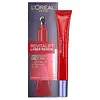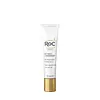What's inside
What's inside
 Key Ingredients
Key Ingredients

 Benefits
Benefits

 Concerns
Concerns

 Ingredients Side-by-side
Ingredients Side-by-side

Water
Skin ConditioningDipropylene Glycol
HumectantDimethicone
EmollientGlycerin
HumectantHydroxypropyl Tetrahydropyrantriol
Skin ConditioningPropylene Glycol
HumectantC12-15 Alkyl Benzoate
AntimicrobialAlcohol Denat.
AntimicrobialDimethicone/Vinyl Dimethicone Crosspolymer
Skin Conditioning2-Oleamido-1,3-Octadecanediol
Skin ConditioningCapryloyl Salicylic Acid
ExfoliatingDisodium EDTA
Hydrolyzed Hyaluronic Acid
HumectantPotassium Hydroxide
BufferingSodium Chloride
MaskingSodium Citrate
BufferingAscorbyl Glucoside
AntioxidantTocopherol
AntioxidantCetyl Alcohol
EmollientOctyldodecanol
EmollientSilica
AbrasiveCarbomer
Emulsion StabilisingCI 77891
Cosmetic ColorantGlyceryl Stearate
EmollientHydroxyethylcellulose
Emulsion StabilisingMica
Cosmetic ColorantMyristic Acid
CleansingPalmitic Acid
EmollientPEG-100 Stearate
Potassium Cetyl Phosphate
EmulsifyingStearic Acid
CleansingTin Oxide
AbrasiveXanthan Gum
EmulsifyingBenzyl Alcohol
PerfumingCitronellol
PerfumingLimonene
PerfumingLinalool
PerfumingCI 15985
Cosmetic ColorantCI 19140
Cosmetic ColorantPhenoxyethanol
PreservativeParfum
MaskingWater, Dipropylene Glycol, Dimethicone, Glycerin, Hydroxypropyl Tetrahydropyrantriol, Propylene Glycol, C12-15 Alkyl Benzoate, Alcohol Denat., Dimethicone/Vinyl Dimethicone Crosspolymer, 2-Oleamido-1,3-Octadecanediol, Capryloyl Salicylic Acid, Disodium EDTA, Hydrolyzed Hyaluronic Acid, Potassium Hydroxide, Sodium Chloride, Sodium Citrate, Ascorbyl Glucoside, Tocopherol, Cetyl Alcohol, Octyldodecanol, Silica, Carbomer, CI 77891, Glyceryl Stearate, Hydroxyethylcellulose, Mica, Myristic Acid, Palmitic Acid, PEG-100 Stearate, Potassium Cetyl Phosphate, Stearic Acid, Tin Oxide, Xanthan Gum, Benzyl Alcohol, Citronellol, Limonene, Linalool, CI 15985, CI 19140, Phenoxyethanol, Parfum
Water
Skin ConditioningGlycerin
HumectantLactose
HumectantC12-15 Alkyl Benzoate
AntimicrobialCetearyl Ethylhexanoate
EmollientGlyceryl Stearate
EmollientPEG-100 Stearate
PEG-8
HumectantRetinol
Skin ConditioningDihydroxy Methylchromone
AntioxidantMagnesium Aspartate
Skin ConditioningZinc Gluconate
Skin ConditioningCopper Gluconate
Skin ConditioningPanthenol
Skin ConditioningTocopheryl Acetate
AntioxidantAscorbic Acid
AntioxidantSorbitol
HumectantStearyl Alcohol
EmollientIsopropyl Myristate
EmollientPropyl Gallate
AntioxidantTromethamine
BufferingCarbomer
Emulsion StabilisingPolysorbate 20
EmulsifyingMethyl Methacrylate/Glycol Dimethacrylate Crosspolymer
Chlorhexidine Digluconate
AntimicrobialPhenoxyethanol
PreservativeEthylhexylglycerin
Skin ConditioningDisodium EDTA
BHT
AntioxidantCitric Acid
BufferingWater, Glycerin, Lactose, C12-15 Alkyl Benzoate, Cetearyl Ethylhexanoate, Glyceryl Stearate, PEG-100 Stearate, PEG-8, Retinol, Dihydroxy Methylchromone, Magnesium Aspartate, Zinc Gluconate, Copper Gluconate, Panthenol, Tocopheryl Acetate, Ascorbic Acid, Sorbitol, Stearyl Alcohol, Isopropyl Myristate, Propyl Gallate, Tromethamine, Carbomer, Polysorbate 20, Methyl Methacrylate/Glycol Dimethacrylate Crosspolymer, Chlorhexidine Digluconate, Phenoxyethanol, Ethylhexylglycerin, Disodium EDTA, BHT, Citric Acid
 Reviews
Reviews

Ingredients Explained
These ingredients are found in both products.
Ingredients higher up in an ingredient list are typically present in a larger amount.
C12-15 Alkyl Benzoate is made up of Benzoic Acid and long chain alcohols. It has a low molecular weight.
C12-15 Alkyl Benzoate is an emollient and texture enhancer. Due to its solubility, it is often used in sunscreens to help evenly distribute active ingredients.
As an emollient, C12-15 Alkyl Benzoate helps soften and hydrate your skin. Emollients create a film on your skin that traps moisture within.
This ingredient has been reported to cause eye irritation.
Learn more about C12-15 Alkyl BenzoateCarbomer is a polymer of acrylic acid. Its main role is to create a gel consistency.
A high amount of carbomer can cause pilling or balling up of products. Don't worry, most products contain 1% or less of carbomer.
Disodium EDTA plays a role in making products more stable by aiding other preservatives.
It is a chelating agent, meaning it neutralizes metal ions that may be found in a product.
Disodium EDTA is a salt of edetic acid and is found to be safe in cosmetic ingredients.
Learn more about Disodium EDTAGlycerin is already naturally found in your skin. It helps moisturize and protect your skin.
A study from 2016 found glycerin to be more effective as a humectant than AHAs and hyaluronic acid.
As a humectant, it helps the skin stay hydrated by pulling moisture to your skin. The low molecular weight of glycerin allows it to pull moisture into the deeper layers of your skin.
Hydrated skin improves your skin barrier; Your skin barrier helps protect against irritants and bacteria.
Glycerin has also been found to have antimicrobial and antiviral properties. Due to these properties, glycerin is often used in wound and burn treatments.
In cosmetics, glycerin is usually derived from plants such as soybean or palm. However, it can also be sourced from animals, such as tallow or animal fat.
This ingredient is organic, colorless, odorless, and non-toxic.
Glycerin is the name for this ingredient in American English. British English uses Glycerol/Glycerine.
Learn more about GlycerinGlyceryl Stearate is a mix of glycerin and stearic acid.
It is used to stabilize the mixing of water and oil ingredients. By preventing these ingredients from separating, it can help elongate shelf life. It can also help thicken the product's texture.
As an emollient, it helps soften skin and supports barrier-replenishing ingredients.
In cosmetics, Glyceryl Stearate is often made from vegetable oils or synthetically produced.
This ingredient may not be fungal-acne safe
Fun fact: The human body also creates Glyceryl Stearate naturally.
Learn more about Glyceryl StearatePeg-100 Stearate is an emollient and emulsifier. As an emollient, it helps keep skin soft by trapping moisture in. On the other hand, emulsifiers help prevent oil and water from separating in a product.
PEGS are a hydrophilic polyether compound . There are 100 ethylene oxide monomers in Peg-100 Stearate. Peg-100 Stearate is polyethylene glycol ester of stearic acid.
Phenoxyethanol is a preservative that has germicide, antimicrobial, and aromatic properties. Studies show that phenoxyethanol can prevent microbial growth. By itself, it has a scent that is similar to that of a rose.
It's often used in formulations along with Caprylyl Glycol to preserve the shelf life of products.
Water. It's the most common cosmetic ingredient of all. You'll usually see it at the top of ingredient lists, meaning that it makes up the largest part of the product.
So why is it so popular? Water most often acts as a solvent - this means that it helps dissolve other ingredients into the formulation.
You'll also recognize water as that liquid we all need to stay alive. If you see this, drink a glass of water. Stay hydrated!
Learn more about Water